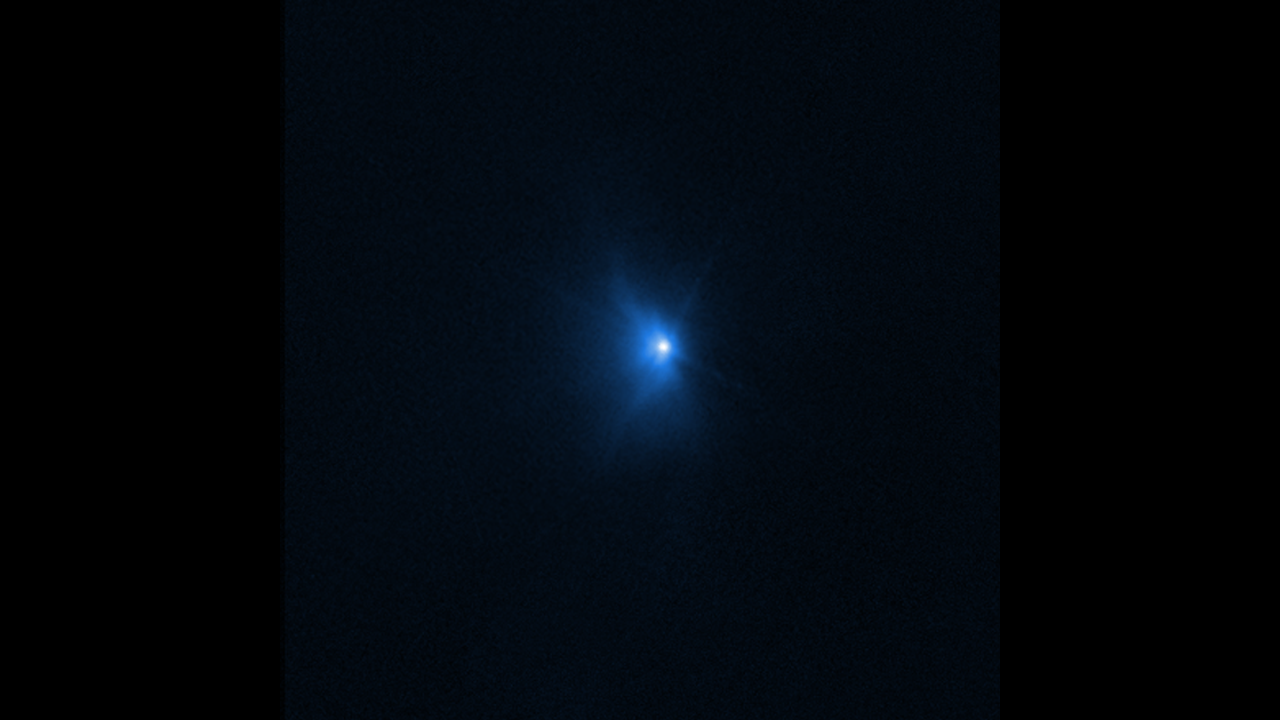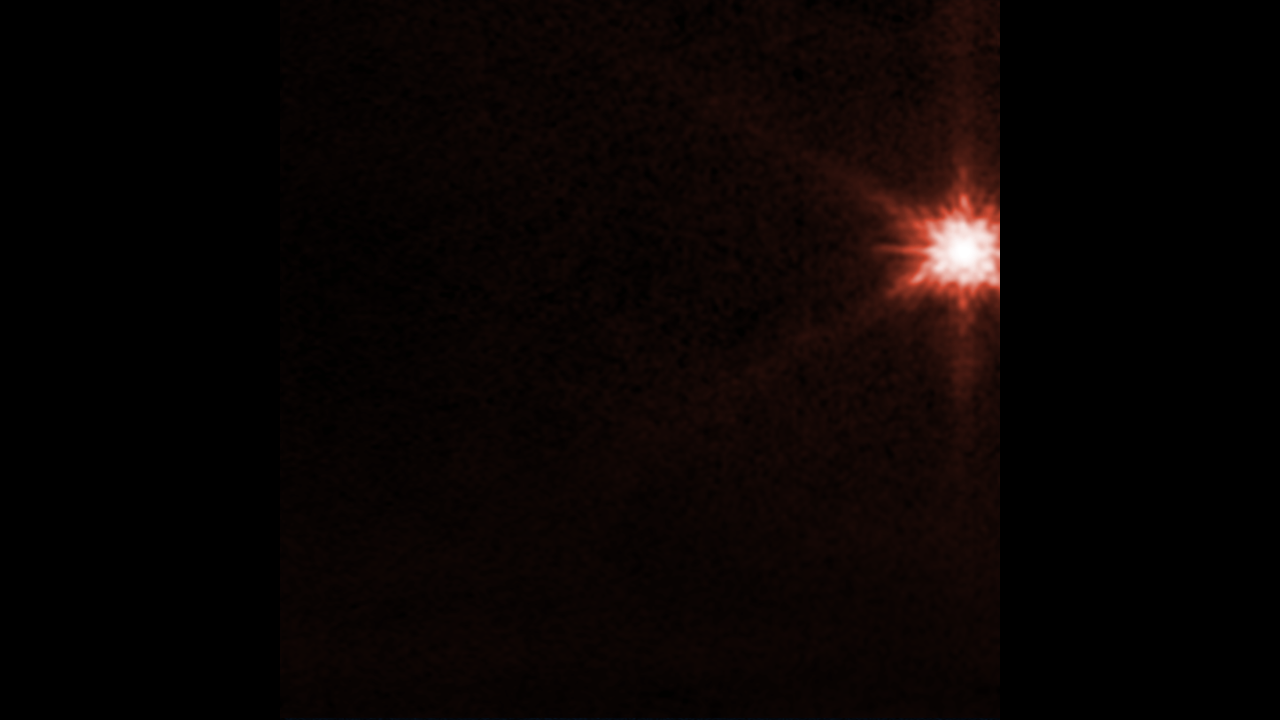1 min read
Hubble/Webb Side-by-Side of Dimorphos Ejecta

For the first time, NASA’s James Webb Space Telescope and Hubble Space Telescope have taken simultaneous observations of the same target.
These images, Hubble on left and Webb on the right, show observations of the Didymos-Dimorphos system several hours after NASA’s Double Asteroid Redirection Test (DART) intentionally impacted the moonlet asteroid. It was the world’s first test of the kinetic impact technique using a spacecraft to deflect an asteroid by modifying its orbit.
Both Webb and Hubble observed the asteroid before and after the collision took place.
Scientists will use the combined observations from Hubble and Webb to gain knowledge about the nature of the surface of Dimorphos, how much material was ejected by the collision, how fast it was ejected, and the distribution of particle sizes in the expanding dust cloud.
In the coming months, scientists will also use Webb’s Mid-Infrared Instrument (MIRI) and Near-Infrared Spectrograph (NIRSpec) to observe ejecta from Dimorphos further. Spectroscopic data will provide researchers with insight into the asteroid’s composition. Hubble will monitor Dimorphos ten more times over the next three weeks to monitor how the ejecta cloud expands and fades over time.
Hubble observations were conducted in one filter, WFC3/UVIS F350LP (assigned the color blue), while Webb observed at F070W (0.7 microns, assigned the color red).
NIRCam was built by a team at the University of Arizona and Lockheed Martin’s Advanced Technology Center.
About the Data
- Data DescriptionData DescriptionProposal: A description of the observations, their scientific justification, and the links to the data available in the science archive.
Science Team: The astronomers who planned the observations and analyzed the data. "PI" refers to the Principal Investigator. - InstrumentInstrumentThe science instrument used to produce the data.HST>WFC3/UVISJWST>NIRCam
- Exposure DatesExposure DatesThe date(s) that the telescope made its observations and the total exposure time.26-27 Sept 2022
- FiltersFiltersThe camera filters that were used in the science observations.HST>F350LPJWST>F070W
- Object NameObject NameA name or catalog number that astronomers use to identify an astronomical object.Dimorphos
- Object DescriptionObject DescriptionThe type of astronomical object.Double Asteroid Redirection Test (DART) on asteroid Dimorphos
- Release DateSeptember 29, 2022
- Science ReleaseWebb, Hubble Capture Detailed Views of DART Impact
- CreditNASA, ESA, CSA, Jian-Yang Li (PSI), Cristina Thomas (Northern Arizona University), Ian Wong (NASA-GSFC); Image Processing: Joseph DePasquale (STScI), Alyssa Pagan (STScI)

The images are single exposures acquired by the WFC3 instrument on the Hubble Space Telescope and the by the NIRCam instrument on the James Webb Space Telescope. The color results from assigning a blue hue to a monochromatic (grayscale) hubble image and a red hue to a monochromatic (grayscale) Webb image. Blue: HST>F350LP Red: JWST>F070W

Related Images & Videos

Hubble Views of Dimorphos Ejecta
These images from NASA’s Hubble Space Telescope, taken 22 minutes, 5 hours, and 8.2 hours after NASA’s Double Asteroid Redirection Test (DART) intentionally impacted Dimorphos, show expanding plumes of ejecta from the asteroid’s body. This event was the world’s first test of the...

Webb View of Dimorphos Ejecta (NIRCam)
This image from NASA’s James Webb Space Telescope’s Near-Infrared Camera (NIRCam) instrument shows Dimorphos, the asteroid moonlet in the double-asteroid system of Didymos, about 4 hours after NASA’s Double Asteroid Redirection Test (DART) made impact. A tight, compact core and...

Hubble/Webb Side-by-Side (WFC3/NIRCam Compass Image)
Image is two columns, the column on the left is a photo with a black background and a bright blue spot at the center, labeled as Hubble. There is a bright haze around the dot, which is the Didymos-Dimorphos system, along with 5 diffraction spikes extending outward. The photo on...

Hubble Time-Lapse of Dimorphos Ejecta
This animated gif combines three of the images NASA’s Hubble Space Telescope captured after NASA’s Double Asteroid Redirection Test (DART) intentionally impacted Dimorphos, a moonlet asteroid in the double asteroid system of Didymos. The animation spans from 22 minutes after...

Webb Time-Lapse of Dimorphos Ejecta
This animation features a time-lapse of images from NASA’s James Webb Space Telescope showing the aftermath of NASA’s Double Asteroid Redirection Test (DART) intentionally slamming into the moonlet asteroid Dimorphos. This animation covers the time spanning just before impact at...
Share
Details
Claire Andreoli
NASA’s Goddard Space Flight Center
Greenbelt, Maryland
claire.andreoli@nasa.gov




























